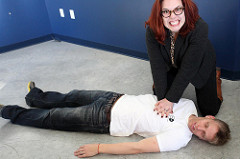It’s one of the scariest moments of one’s life. The heart stops beating. The patient stops breathing. The doctors, in a flurry of indecipherable moments, start administering CPR. The terrified, grief-stricken family is rushed out behind a curtain, to—
Wait. But are they really?
A recent study, conducted at the University of Michigan, has shown that whether families stay or not during CPR (cardiopulmonary resuscitation) has a negligible effect on the the survival rate of the patient. In the study, 41,568 patients from 252 different hospitals underwent CPR, and 13,470 patients had families present during CPR. Across the board, over 57% of all the patients had their hearts successfully restarted through CPR.
Image Source: Justin Sullivan
Historically, families have not been allowed in the same room as the patient because medical professionals believed it could possibly distract them from the task at hand and that it also would upset and panic the family. However, research from The New England Journal of Medicine has shown that families who were able to watch CPR experience less depression and post-traumatic stress symptoms, mainly because families who observed the physicians came away from the experience feeling that all of their resources had been used to their fullest extent. Therefore, through witnessing CPR, families are able to better grasp the fact that the medical team exerted their best efforts to save the patient, regardless of the outcome. The families are able to battle an intimidating experience with more knowledge about the process of CPR and how it is administered. This allows loved ones to have more closure in the event of the patient’s death.
Even if families are unable to be in the emergency room during the entire CPR process, a physician can still frequently update them on the status of their loved one. With this information, families are better able to make decisions in place of the patient, with the option of stopping the CPR process at any given time.
Knowledge is power. With more knowledge about the CPR process and how it is administered, families will be able to better understand the positions and actions of medical professionals. In addition, more knowledge will make the CPR process less intimidating and more relatable, helping bridge the often-wide gap existing between medical professionals and the general public.
Feature Image Source: CPR by sharyn morrow










